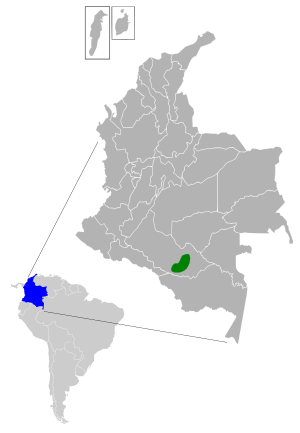Chiribiquete emerald facts for kids
Quick facts for kids Chiribiquete emerald |
|
|---|---|
| Conservation status | |
| Scientific classification | |
| Genus: |
Chlorostilbon
|
| Species: |
olivaresi
|
 |
|
The Chiribiquete emerald (Chlorostilbon olivaresi) is a beautiful species of hummingbird. It belongs to a group of hummingbirds called "emeralds." This special bird lives only in southern Colombia.
Contents
About the Chiribiquete Emerald
How it Got its Name
Scientists first described the Chiribiquete emerald in 1996. Its scientific name, olivaresi, honors a person named Father Antonio Olivares. He was a very important person in studying birds in Colombia. He also worked hard to build a collection of birds for a university museum.
What it Looks Like
The Chiribiquete emerald is a small bird, about 8.5 to 9 centimeters (around 3.5 inches) long. Males weigh about 3.8 grams, and females are a bit lighter at 3.6 grams.
- Male Birds:
- Their beak has a black upper part and a red lower part with a black tip.
- Their upper body is a shiny metallic green.
- The feathers covering their upper tail are bluish green.
- Their tail is a dark steel blue and has a slight fork shape.
- The sides of their head and neck shine with a golden green color.
- Their throat and upper chest are a sparkling blue-green.
- The rest of their belly is a bright metallic green.
- Female Birds:
- Their beak is black, with a hint of red at the base of the lower part.
- Their upper body is a metallic bronze-green.
- Their belly is a pale gray.
- They have a dark face and a white stripe behind each eye.
- Most of their tail is bluish green. The outer tail feathers have gray bases, a dark blue band, and white tips.
Where the Chiribiquete Emerald Lives
Its Home in Colombia
This hummingbird lives only in the Serranía de Chiribiquete. This is a range of flat-topped mountains in south-central Colombia. It is found in the Guaviare and Caquetá departments.
Its Preferred Habitat
The Chiribiquete emerald mostly lives in open areas with scrub bushes and savannas. These are found in the middle and upper parts of the mountains. It can also be found in forests at slightly lower elevations. However, it does not like the lowlands around the mountains. These birds live at elevations between 800 and 1600 meters (about 2,600 to 5,200 feet) above sea level.
How the Chiribiquete Emerald Behaves
Staying in One Place
Scientists believe that the Chiribiquete emerald does not migrate. It likely stays in the same area all year round.
What it Eats
The most important food source for this hummingbird is the nectar from a low shrub called Decagonocarpus cornutus. It also drinks nectar from the flowers of other shrubs and trees. Unlike some hummingbirds, it does not seem to protect its feeding areas from other birds. Besides nectar, it also eats small insects. It catches insects by flying out from a perch through gaps in plants. It also picks insects off flowers and leaves.
Breeding Habits
The Chiribiquete emerald probably lays its eggs during the dry season, which is from December to May. We do not know much about its nest or other details about its breeding habits.
Its Calls
Scientists have not yet described the song of the Chiribiquete emerald. However, when it is looking for food, it makes a short, dry, scratchy sound that sounds like "cht."
Protecting the Chiribiquete Emerald
The IUCN (International Union for Conservation of Nature) says the Chiribiquete emerald is of "Least Concern." This means it is not currently in danger of disappearing. Even though it lives in a small area and we don't know its exact population size, most of its home is inside the Chiribiquete National Park. There is not much human activity on the mountaintops where it lives. This means there are no immediate threats to this special hummingbird.
See also
 In Spanish: Esmeralda del Chiribiquete para niños
In Spanish: Esmeralda del Chiribiquete para niños


